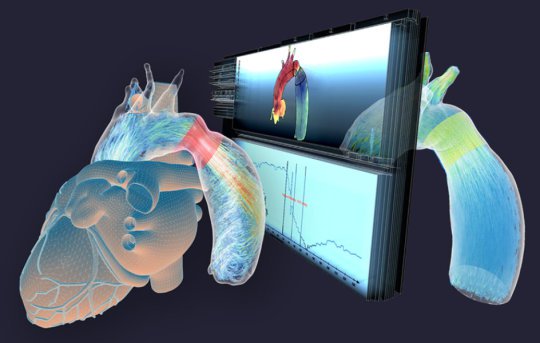
Children with congenital heart defects often undergo a battery of strenuous examinations and interventions. Now, researchers have developed software to simulate certain interventions in advance. Preliminary results point to a reduced need to perform numerous interventions.
It can come as a shock to parents: when coarctation of the aorta affects a newborn, the aorta is so narrow that associated heart problems could threaten the life of the child. Fortunately, these heart defects can now be successfully treated with stents. Multiple treatments, however, are often spread over many years, which can be exhausting for child and parent. The Fraunhofer Institute for Medical Image Computing MEVIS in Bremen, Germany has developed software to simulate and compare various types of interventions. This could improve therapy quality and help determine the necessity of an intervention, thereby sparing some young patients from having to undergo an operation. The research was completed as part of the EU CARDIOPROOF project, which will be concluded at the end of 2016.
The computer simulation is based on images of a patient's heart taken with an MRI scanner. These images show not only the shape of the blood vessels, but also portray blood flow. "Our algorithms can detect which blood pressure conditions are found in the vessels," according to Dr. Anja Hennemuth, researcher at Fraunhofer MEVIS. "Important is the degree to which the blood pressure differs before and after a vascular constriction." Based upon a blood flow simulation, experts can replicate and estimate different types of interventions on a computer and determine their effect on patients' blood flow and pressure.
Virtual Blood Vessel Testing
With these advances, researchers can inflate a virtual balloon catheter and assess its effects on blood flow and pressure or plan the insertion of a variety of stents on a computer. This so-called "virtual stenting" helps choose the most suitable stent and its placement. "With the help of our software, clinicians can make informed decisions about which type of intervention is most appropriate and whether the intervention can be delayed or even forgone," states Hennemuth. CARDIOPROOF aims to develop a real-world system for clinical use. "We wanted to develop methods that could be employed for daily use. The research team in Bremen worked closely with the project's partner clinics to discover how the new software could best be integrated into the hospitals' routines. Even the graphical user interface was designed and tested in cooperation with partner clinicians.
Software Calculates Blood Flow and Pressure
To test how realistic the computer simulations were, the scientists conducted clinical studies at the German Heart Center in Berlin. In addition, young patients were examined after the interventions using an MRI scanner. This allowed blood flow before and after their intervention to be calculated and compared to the simulation. The results show accurate predictions of blood flow and pressure.
With the assistance of the web-based software, clinicians can reconstruct blood flow and pressure in the aorta in under half an hour. Thereafter, a virtual intervention can be performed by the clinicians. The results of the simulation are usually ready within another half hour. "We have shown the applicability for the clinical practice," states Anja Hennemuth. "The next steps include quality assurance, certification, and transfer into a commercial solution." Lynkeus, one of CARDIOPROOF's industrial partners, has already submitted a follow-up project proposal to the EU.
Computer simulations not only reduce strain on children and their parents, but also save health care costs. As a partner in the project, the London School of Economics produced a detailed analysis of the financial and organizational uses of the new method compared to those in current practice. Results show that because the software reduces the number of complications and follow-up treatments, in an ideal case, the cost per patient could be cut by up to ten percent.

 Previous page
Previous page Back to top
Back to top







